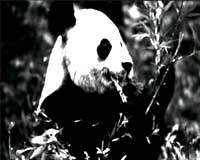


the Chinese giant panda (Ailuropoda melanoleuca), has become a symbol of international efforts at protecting endangered species. There are around a 1,000 of these 10 million-year-old 'living fossils' living in the wild, and about 100 more in 29 zoos and research centres within China.
A five-year-project to produce the world's first giant panda through in vitro fertilisation (ivf), has sparked a debate over a number of issues. The status of the funding of environmental research and the scientific agenda of the country are both being placed under the microscope. Officials from the ministry responsible for zoos and captive breeding and the ministry in charge of wildlife preservation and conservation, are competing with each other for scarce resources.
Although researchers have used artificial insemination successfully for almost two decades, the proposal to try ivf has triggered a scientific dispute. Chinese scientists have spent years studying the panda's reproductive system, hormone biology, semen characteristics, pregnancy and nursing behaviour. In the year 1978, the Beijing zoo witnessed the birth of the first panda from the use of artificial insemination. This was followed by the successful use of frozen and then thawed semen at Chengdu zoo in the Sichuan province of China.
Unfortunately, these efforts have not done much good for resurrecting the dwindling population of pandas. Artificial insemination remains only an experimental procedure marked with limited success.
A team of 14 veterinarians, zoologists and engineers - working at the Embryo Engineering Laboratory for giant pandas and other endangered and rare wildlife species, in Chengdu - views test-tube technology and embryo transplanting as the breakthrough required for increasing the population of pandas. They hope to extract ova either from the ovary of a deceased female panda or from a captive panda. Mature ova will be fertilised and if a zygote results, it will be nurtured in a test-tube and then kept frozen at a temperature of 196
Links:
[1] http://admin.indiaenvironmentportal.org.in/news/struggling-conserve
[2] http://admin.indiaenvironmentportal.org.in/category/newspaper/down-earth
[3] http://admin.indiaenvironmentportal.org.in/category/thesaurus/endangered-species
[4] http://admin.indiaenvironmentportal.org.in/category/thesaurus/wildlife
[5] http://admin.indiaenvironmentportal.org.in/category/thesaurus/china